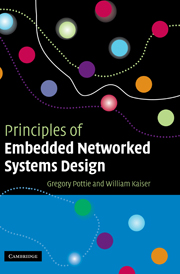Book contents
- Frontmatter
- Contents
- Preface
- Acknowledgments
- List of Abbreviations
- 1 Embedded network systems
- 2 Representation of signals
- 3 Signal propagation
- 4 Sensor principles
- 5 Source detection and identification
- 6 Digital communications
- 7 Multiple source estimation and multiple access communications
- 8 Networking
- 9 Network position and synchronization services
- 10 Energy management
- 11 Data management
- 12 Articulation, mobility, and infrastructure
- 13 Node architecture
- 14 Network data integrity
- 15 Experimental systems design
- 16 Ethical, legal, and social implications of ENS
- 17 Design principles for ENS
- Appendix A Gaussian Q function
- Appendix B Optimization
- Index
12 - Articulation, mobility, and infrastructure
Published online by Cambridge University Press: 10 August 2009
- Frontmatter
- Contents
- Preface
- Acknowledgments
- List of Abbreviations
- 1 Embedded network systems
- 2 Representation of signals
- 3 Signal propagation
- 4 Sensor principles
- 5 Source detection and identification
- 6 Digital communications
- 7 Multiple source estimation and multiple access communications
- 8 Networking
- 9 Network position and synchronization services
- 10 Energy management
- 11 Data management
- 12 Articulation, mobility, and infrastructure
- 13 Node architecture
- 14 Network data integrity
- 15 Experimental systems design
- 16 Ethical, legal, and social implications of ENS
- 17 Design principles for ENS
- Appendix A Gaussian Q function
- Appendix B Optimization
- Index
Summary
Gathering data concerning the physical world is at many levels a progressive exercise in uncertainty reduction. There is uncertainty in the signal propagation model, the calibration of the sensor, the model of the phenomenon, and in the communications process. A system that can add resources where uncertainty is greatest can potentially achieve a similar level of uncertainty reduction as a network where nodes are uniformly deployed at high density. The more varied the environment and the less certain the initial models the greater the potential benefit of mobility of sensing and communication resources. This chapter is concerned with the interaction of mobile and static nodes, with mobility of three types considered:
articulation of elements such as directional antennas, photovoltaic panels, or sensors to gain better position;
use of freely mobile nodes that may act to supply a static network or provide mobile communication or sensing means;
infrastructure to support mobility, communications, and energy distribution and the implications for static or freely mobile elements.
Our scope does not include details of how mobile elements can actually be made to work in an autonomous fashion whether individually or in teams; this requires far more detail than can be provided here. Our focus is rather on how the fact of mobility in some combination of the above forms can fundamentally change the sensor network problem set.
Articulation
Articulation of a mechanical device consists of some combination of rotation and extension/retraction.
Information
- Type
- Chapter
- Information
- Principles of Embedded Networked Systems Design , pp. 368 - 393Publisher: Cambridge University PressPrint publication year: 2005
